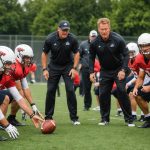Understanding the dynamics of home-court advantage in basketball is crucial for both fans and players alike. When your favorite NBA team plays in front of a crowd of enthusiastic supporters, the atmosphere can be electric. But what exactly gives teams that extra edge on their home court? This article delves into the various factors that contribute to the home-court advantage, providing insights into how these elements can impact the performance of teams during critical games in the season.
The Impact of Familiarity with the Court
One of the primary reasons for the home-court advantage is the players’ familiarity with their playing surface. Each court has unique characteristics, including the dimensions, the quality of the flooring, and even the baskets’ rim height. When teams practice on their home court, they develop a feel for these nuances, allowing them to perform better during actual games.
Additional reading : Top Stretching Techniques to Help UK Basketball Players Prevent Injuries and Boost Performance
Moreover, this familiarity extends beyond just the physical aspects of the court. Players understand how the ball bounces on their home court, which can significantly influence shooting accuracy and rebound statistics. For instance, teams that have mastered their home court may have an advantage when it comes to three-point shooting, as they are more accustomed to the angles and distances involved.
Additionally, the psychological comfort of playing on familiar turf cannot be overlooked. Players often feel more at ease when they are in a setting they know well, which can lead to a more confident performance. This confidence can manifest in various ways, from more aggressive offense to better defensive strategies, ultimately contributing to a higher likelihood of securing victory.
Also to see : Unlocking Peak Performance: The Impact of Resistance Training on UK Basketball Players
In essence, the home-court advantage is largely rooted in the players’ understanding of their environment. This intricate bond between the players and their playing surface provides a significant boost in performance, especially during the high-pressure moments of the season.
The Role of the Home Crowd
The crowd plays a pivotal role in enhancing the home-court advantage. When fans pack the stands, they create an atmosphere that can elevate the performance of their team. The psychological impact of playing in front of supportive fans cannot be underestimated; it often leads to increased motivation and focus among players.
A loud and enthusiastic crowd can disrupt the opposing team’s communication, making it difficult for them to execute plays effectively. For example, if a visiting team struggles to hear the coach’s instructions due to the deafening noise from the stands, this can lead to confusion and mistakes during crucial moments.
Additionally, the emotional rallying of the fans can energize players, pushing them to perform at their best. This emotional connection between the team and its supporters fosters a sense of unity and purpose, which is often palpable during games. Players find themselves feeding off the energy of the crowd, leading to spectacular plays that might not happen in a quieter environment.
Moreover, the home crowd often creates a sense of intimidation for visiting teams. This psychological warfare can lead to increased pressure on opponents, causing them to falter under the weight of expectations. In a series where every point counts, such psychological advantages can make a significant difference in the outcome of a game. Ultimately, the dynamic interaction between the players and the crowd is a key component of the home-court advantage in basketball.
Travel Fatigue and Its Effects
Travel can be a significant factor contributing to the home-court advantage. When a team plays away from home, they often face the additional burden of travel fatigue. Long trips can disrupt a player’s routine, affect their sleep patterns, and generally increase stress levels.
In contrast, the home team enjoys the comfort of sleeping in their own beds and maintaining their regular schedules. This familiarity can play a crucial role in their performance, particularly if they are well-rested and mentally prepared for the game. Studies have shown that teams coming off long road trips often struggle to perform at their best, especially if they are facing strong opponents on their home court.
Moreover, the timing of games can further exacerbate this issue. If a team has to travel across time zones, they may experience jet lag, which can impair their physical and cognitive abilities during the game. For instance, a team flying from the West Coast to the East Coast may find themselves playing at a time that feels much earlier than normal, leading to decreased performance levels.
These factors illustrate how travel fatigue can tip the scales in favor of the home team, granting them an edge that is often decisive in tight contests. Therefore, understanding the implications of travel in the context of the home-court advantage is essential for fans and analysts alike.
Coaching Strategies and Preparation
Coaching plays a vital role in maximizing the home-court advantage. Coaches have the opportunity to tailor their strategies based on the unique attributes of their court and the dynamics of playing in front of a supportive crowd. They can use their knowledge of the environment to optimize their team’s performance.
For instance, a wise coach might adjust their tactics to exploit the weaknesses of the visiting team, such as their inability to handle pressure or their discomfort with the local environment. This can involve specific plays that capitalize on the home crowd’s energy, encouraging players to engage in high-tempo offense or aggressive defense, especially during crucial moments of the game.
Additionally, the preparation for home games can differ significantly from away games. Coaches often implement specific drills that prepare players for the unique conditions that come with playing at home. From shooting drills that focus on the nuances of the court to situational practices that simulate high-pressure scenarios, the preparation is tailored to enhance performance in familiar territory.
Furthermore, the ability to have more frequent practice sessions on their home court allows teams to refine their skill sets and teamwork dynamics. This not only boosts player confidence but also fosters a strong sense of camaraderie among teammates. A well-prepared team is often more resilient, making them a formidable force when playing at home.
In summary, effective coaching strategies and personalized preparations are crucial elements that enhance the home-court advantage in basketball. These strategies not only equip players with the necessary skills but also instill a winning mentality, setting the stage for success.
In conclusion, the home-court advantage in basketball is a multifaceted phenomenon shaped by various elements. From the players’ familiarity with the court to the electrifying energy of the crowd, and the impact of travel fatigue to strategic coaching practices, each factor contributes to a team’s performance. Understanding these dynamics provides valuable insights for fans and analysts alike, enhancing the appreciation of the game. As you watch your favorite NBA team take to the court, remember that their success at home is often a result of these intricate interactions, making every game a thrilling spectacle full of emotion and strategic depth.











